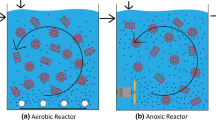Abstract
Anaerobic sequencing batch reactors containing granular or flocculent biomass have been employed successfully in the treatment of piggery wastewater. However, the studies in which these reactors were employed did not focus specifically on accelerating the hydrolysis step, even though the degradation of this chemical oxygen demand (COD) fraction is likely to be the limiting step in many investigations of this type of wastewater. The mechanically stirred anaerobic sequencing batch biofilm reactor offers an alternative for hastening the hydrolysis step, because mechanical agitation can help to speed up the reduction of particle sizes in the fraction of particulate organic matter. In the present study, a 4.5-L reactor was operated at 30°C, with biomass immobilized on cubic polyurethane foam matrices (1 cm of side) and mechanical stirring provided by three flat-blade turbines (6 cm) at agitation rates varying from 0 to 500 rpm. The reactor was operated to treat diluted swine waste, and mechanical stirring efficiently improved degradation of the suspended COD. The operational data indicate that the reactor remained stable during the testing period. After 2 h of operation at 500 rpm, the suspended COD decreased by about 65% (from 1500 to 380 mg/L). Apparent kinetic constants were also calculated by modified first-order expressions.
Similar content being viewed by others
References
Kennedy, K. J. and Van den Berg, L. (1982), Agric. Wastes 4, 151–158.
Lomas, J. M., Urbano, C., and Camarero, L. M. (2000), Biomed. Bioeng. 18, 421–430.
Ng, W. J. and Chin, K. K. (1987), Agric. Wastes 20, 157–166.
Young, P. Y. and Chou, C. Y. (1985), Agric. Wastes 14, 221–239.
Bolte, J. P., Hill, D. T., and Wood, T. H. (1986), Trans. ASAE 29, 543–549.
Ng, W. J. (1989), Biol. Wastes 28, 39–51.
Dague, R. R., Habben, C. E., and Pidaparti, S. R. (1992), Water Sci. Technol. 26, 2429–2432.
Zhang, R. H., Yin, Y., Sung, S., and Dague, R. R. (1995), Trans. ASAE 40, 761–767.
Angenent, L. T., Sung, S., and Raskin, L. (2002), Water Res. 36, 4648–4654.
Bolte, J. P., Hill, D. T., and Wood, T. H. (1986), Trans. ASAE 29, 543–549.
Levine, A. D., Tchobanaglous, G., and Asano, T. (1985), J. WPCF 57, 805–816.
Ratusznei, S. M., Rodrigues, J. A. D., Camargo, E. F. M., Zaiat, M., and Borzani, W. (2000), Bioresour. Technol. 75, 127–133.
Cubas, S. A., Foresti, E., Rodrigues, J. A. D., Ratusznei, S. M., and Zaiat, M. (2004), Biochem. Eng. J. 17, 99–105.
Ratusznei, S. M., Rodrigues, J. A. D., and Zaiat, M. (2003), Water Sci. Technol. 48, 179–186.
Pinho, S. C., Ratusznei, S. M., Rodrigues, J. A. D., Foresti, E., and Zaiat, M. (2005), Bioresour. Technol. 96, 517–519.
Pinho, S. C., Ratusznei, S. M., Rodrigues, J. A. D., Foresti, E., and Zaiat, M. (2004), Water Res. 38, 4117–4124.
APHA/AWWA/WEF. (1998), Standard Methods for Examination of Water and Wastewater, 20th ed., EUA, Washington, DC.
Peterson, G. L. (1977), Anal. Chem. 83, 346–353.
Dubois, M., Gilles, K. A., Hamilton, J. K., Rebers, P. A., and Smith, F. (1956), Anal. Chem. 28, 350–356.
Blundi, C. E. and Gadelha, R. F. (2001), in Post-Treatment of Anaerobic Reactors Effluents: Methodological Aspects, Chernicharo, C. A. L., ed., PROSAB, Belo Horizonte, MG, Brazil, pp. 9–17 (in Portuguese).
Postma, T. and Stroes, J. A. P. (1968), Clin. Chim. Acta 22, 569–578.
Alves, M. M., Vieira, J. A. M., Pereira, R. M. A., Pereira, A., and Mota, M. (2001), Water Res. 35, 255–263.
Henze, M. and Harremoës, P. (1983), Water Sci. Technol. 15, 1–101.
Author information
Authors and Affiliations
Corresponding author
Rights and permissions
About this article
Cite this article
de Pinho, S.C., Fernandes, B.S., Rodrigues, J.A.D. et al. Feasibility of treating swine manure in an anaerobic sequencing batch biofilm reactor with mechanical stirring. Appl Biochem Biotechnol 120, 109–120 (2005). https://doi.org/10.1385/ABAB:120:2:109
Received:
Revised:
Accepted:
Issue Date:
DOI: https://doi.org/10.1385/ABAB:120:2:109




